Sculpture
Sculpture In ancient and early medieval periods (up to 1200 AD), Bengal saw both expansion and contraction of her political control over eastern India and, as a consequence, her cultural influence in the region also fluctuated. For an orderly presentation of the story of Bengal sculpture it is imperative to keep in mind such important historical factors. In the best days of the Pala kings, who ruled between c 750 AD and 1200 AD, Bengal achieved her widest political hegemony over northeast India. Though the homeland of the Palas was north Bengal, in the larger part of their long rule Bihar was an integral part of their kingdom. But before them, except shashanka (c 600 AD - 625 AD), no other Bengal king is known to have ruled outside his own land. So it would be out of our scope to take into account the achievement of the Maurya emperor Ashoka (c BC 273-232) as the patron of glyptic art, though his atelier was situated at Chunar, a place not far from Benaras, and his capital was Pataliputra in south Bihar.
It is actually difficult to pinpoint the beginnings of the art of sculpting in Bengal proper. For, though the lower Ganga valley or south Bengal was a prolific centre of terracotta art at least from the 2nd century BC, there is no clear evidence to show that the art of sculpting was similarly practised in the area from about the same time. The terracotta figures are however extremely significant in determining the stylistic character of Bengal representational art as flourished between the 2nd century BC and the 2nd-3rd century AD. They show that from the very beginning Bengal art was an extension of the art of Ganga-Jamuna valley. The well-known Bharhut style, exhibiting low relief and strict frontality of the figures, and an early sophistication in execution, is as effective in the terracottas of upper Ganga sites as in those of lower Ganga valley.
But what is conspicuous is that while in north-central India there is no dearth of stone relief, in Bengal they are totally absent.
It seems that art of carving on stone had a late start in Bengal, and for easy availability of plastic clay the artist of the region was satisfied with the technique of modelling and moulding. But the art of carving on materials less resistant than stone appears to have been known to him. Several small examples of figures in wood and bone, recently discovered from chandraketugarh in North 24 Parganas and Mangalkot in Bardhaman, both in West Bengal, support the view that carving on wood and bone, and possibly also on ivory, was in practice in this early phase of Bengal art.
Wood and Bone figures Most of the minute carvings, now in the collection of the West Bengal State Archaeological Museum at Calcutta, are broken or abraded. They include six wooden and four bone made figures. The woods represent two slender yaksis, a fish and a handle of a stick or dagger. The bone examples are much more significant from the viewpoint of sculpting, as they show relief as well as figure in round. A medallion of the diameter of 5 cm depicts an amorous couple in a style that is known as Shunga in Indian art history.
While the headgear and the ornaments of heavy beads of the couple remind us of similar figures of Bharhut, their voluptuousness that of Mathura yaksas and yaksis. Another plaque in rectangular shape is relief of a yaksi under a tree and two devotees below, but its craftsmanship is cruder, if compared with that of the medallion. Two yaksis, one in the round and the other in relief, and 6 cm and 10 cm in height, respectively, are very close to similar terracotta figures of the period in their plastic modelling and strict frontality in stance. But a different style is found in a broken as well as highly corroded winged lion, 9 cm in height, also from Chandraketugarh.
The subject, the technique of chiselling, and the lotus capital on which the lion is crouched indicate that the piece of art bears affinity of the art of West Asia, and in all likelihood, it was brought to south Bengal from the Gandhara region of north-west India and Afghanistan. But of all the tiny figures most attractive is the sculpture in the round in fossilised bone found at Mangalkot. In a least abraded state of preservation, this work, 14 cm in height, represents on the front two figures, a yaksa and a yaksi below him, both frontally poised. The backside shows the back of a yaksi.
The plastic treatment of the figures is much more sensitive than those of other bone figures, and hair and apparels are chiselled in minute detail. In sitting posture of the yaksi and in the individual treatment of the ornaments of the figures mastery over the carving tools is clearly manifested. It is also a product of the same early Indian style of the Shungas, but appears to be of a late date, 1st or 2nd century AD.
Early stone sculpture Stone sculptures so far discovered from Bengal proper and assignable to the early three centuries of the Christian era are few. These sculptures in general represent a style, which is, in the development of the art in north India, recognised as of the Kusanas. The centre of the art was Mathura, where evolved during the period the images of the deities worshipped by the followers of the three major religions of the time, namely, Brahmanism, Buddhism and Jainism.
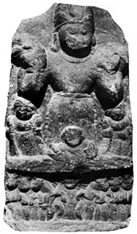
The characteristic features of the figures in Mathura style include emphasis on volume and stolidity, domination of frontality of the earlier days and use of mottled red sandstone as material. Two of the early examples of sculptures found in Bengal are in similar red stone and bear the characteristics of Kusana style, and now preserved in the Asutosh Museum. One of them discovered from Chandraketugarh, shows a Buddha-Bodhisattva exhibiting all the characteristic traits of colossal Kusana Buddha-Bodhisattvas discovered from Mathura region. Though only the upper part of the body remains, the sturdiness of form and the treatment of the upper garment, which covers the left shoulder leaving the right bare, with ridges typical of the Mathura prototype, clearly assign it to the Kusana style of about the 2nd century AD. The other one, of about 55 cm in height, represents the torso of a standing male figure holding a staff, and tentatively identified as of Kartikeya.
Discovered from mahasthan in Bangladesh, the image is also in the same Kusana style, but stylistically belongs to a slightly later date, about the middle of the 3rd century AD. The chiselling of the figure is more sophisticated and the apparel which includes a waistband with a loop-like knot on the side and an under garment of a fine cloth clearly anticipate the diaphanous treatment of the same in the Gupta classical period, two centuries later. The same may be stated about the sensitive plastic presentation of the body and fleshy and lively execution of arms and fingers of the left hand holding the staff.
Three other images, bearing the idioms of Kusana style, are now in the collection of Varendra Research Museum, Rajshahi, Bangladesh. Two of them, representing Surya, are in coarse-grained sandstone. One was found at Kumarpur and the other at Niyamatpur, both in the district of Rajshahi. An extremely coagulated form, the Kumarpur Surya (fig 1) stands on a raised pedestal between two attendants and is drawn on a chariot by seven horses. Aruna, the charioteer, squats in front of the stunted figure of the Sun god. The crude carving of form and wrong anatomical features of the horses show that it is a product of a novice carver who tried his best to imitate a Surya image of the Kusana style.
So far as the quality of carving is concerned the Niyamatpur specimen does not improve much. Its full standing frontal posture, wearing a flat cap and long tunic, as noted in the Kaniska figures on his coins, are however indicative of its affinity with the Kusana Suryas. The third image of the same style, found at Hankrail in the district of Malda, West Bengal, represents standing Visnu. He also wears a tunic down to the knees with a waistband, and shows some other features of the Kusana style. Carved in buff-coloured sandstone, the image exhibits better chiselling of limbs and apparels, and sensitivity almost totally absent in the images of Surya. It is assignable, on stylistic consideration, to the closing years of the 3rd or the beginning of the 4th century AD.
The above discussed sculptures, datable between the 2nd and the 4th century AD, and broadly identifiable as belonging to the Kusana style, clearly suggest that in the period, the art of stone sculpting was in the initial stage. The Asutosh Museum Buddha-Bodhisattva and Kartikeya images were more possibly the products of the Ganga-Yamuna valley than of Bengal. Their material, red sandstone, style and size indicate that the Ganga carried them down stream from the region of Mathura to the river shores of Bengal. On the other hand, the two Surya images of the Varendra Research Museum are so crude in handling the chisel and shape the desired form that they testify to the hesitant use of the tool by the artist of local origin. The Hankrail Visnu of the later date is no doubt indicative of the fact that the art of carving had been somewhat learnt by the artist by that time. In the following two centuries, which correspond to the Gupta period, things were much different and availability of stone sculpture was much frequent and more numerous in Bengal.
Gupta sculpture In the long history of Indian representational art the importance of the Gupta age (c 300 AD-550 AD) can hardly be over emphasised. So far as Indian sculpture is concerned this period witnessed the climax of the art. This climax, of course, pre-supposes continuous experimentation by the artists during the next five hundred years and more. In the Gupta art the laws of proportion, stance and flexion were settled, and iconic features of the gods and goddesses of the three major Indian religions were codified. Above all the art saw the realisation of a three-dimensional aesthetic vision of human forms with two basic characteristics, viz (i) plastic volume and (ii) gliding linearism. Besides, robustness and a cultured restrain in expression endowed the figures of the period with a certain quality that is marked as classical.
Though Bengal, barring her south-eastern region, was an integral part of the Gupta kingdom almost from the beginning, she remained a peripheral region so far as the dominant culture of the period is concerned. Nevertheless, from the presence of quite a number of images stylistically assignable to the period it is possible to trace a connected development of the art in the region at least from the 4th-5th century AD. Here it should, however, be remembered that the examples of sculptures of the same period found in various sites of south Bihar are important as comparable materials for the reason that the Gupta kings ruled their empire from their capital situated in the region, viz Pataliputra, where from, in all possibility, the art of the style spread towards the east.
The Gupta rulers were devoted Vaishnavas, and early Gupta images are found to be mostly representations of Visnu or any of his incarnations. One of the most representative sculptures of the period is an image of Narasingha discovered at Shahkund in the Bhagalpur district of Bihar. The four-handed image bears the four weapons of Visnu, viz shangkha, chakra, gada and padma, and in size and shape is typical of the period. But what makes the image unique is its fully rounded robust form with a lion head on strong shoulder with flowing manes. The proficiency in carving with a clear sense of the plastic variations in apparels, ornaments and the body and limbs of the deity, and the expressive angry look of the lion-face, shape the image differently from those of the preceding Kusana style.
Of the Gupta sculptures in Bengal proper the earliest example seems to be the Visnu from Machmoil Bagmara (fig 2) in the district of Rajshahi carved in gray sandstone. The image shows a broken form of the god in a strict frontally standing pose. Though modelling and iconic features betray its early Gupta style, its aesthetic attainment is so negligible that it may be stylistically placed in a point of transition between the Kusana and the Gupta phases. The image is preserved with quite a number of other Visnus of the Gupta period in the Varendra Research Museum.
Such an unfinished image of Visnu comes from Karaicherchar in Dinajpur, and shows the god in his usual standing posture with four hands carrying the four weapons mentioned above. It is assignable to the 5th century AD, as also the similar image of the god discovered at a place in Khulna district.
This Khulna Visnu, though miniature in size (H. 19 cm), is fully carved in buff sandstone, and shows the Gupta modelling and the physical features more clearly. While the stele of the former Visnu is oval in shape, in the latter its circular form is in cut out. It appears that in the following century the artist of Bengal became sufficiently trained in handling stone material. Such examples as one from Narhata in Bogra district and the other from Khaira in Rajshahi district are indicative of the fact (fig.3). The Visnu from Narhata is carved in the round with a feeling for soft flesh of a relaxed figure and a slight movement. It is being of black basalt, a favoured variety of stone of the Bengal carvers of the following centuries, further strengthens the view.
The Khaira Visnu in grey sandstone, now in mutilated state, stands erect but shows a change in iconographic features, introducing anthropomorphic forms of the weapon-symbols gada and chakra. From this stage it is, however, not difficult to trace the line of evolution of the typical Visnu type of Bengal that dominates the art of the region in the following five hundred years.
Paharpur sculptures The Gupta sculptures of Bengal are mostly icons and their forms were determined by the characteristics of the gods as prescribed by the priests of Madhyadesha or central India. In such forms the artist’s imagination can play only a marginal role. From a series of panels discovered in somapura mahavihara, at paharpur (Bangladesh), it is possible to have at least some glimpses of the formal and aesthetic preferences of the Bengal sculptor. Built in the latter half of the 8th century AD there are as many as sixty-three stone sculptures fixed around the basement wall of the shrine. The sculptures are carved in high relief on stone slabs, not unlike those found on the faces of the basement of a ruined Buddhist shrine at Nalanda.
On stylistic consideration the Paharpur sculptures are divided into three groups. The third group, which includes the large majority of pieces, was most possibly executed along with the shrine itself, and therefore assignable to the 8th century AD. But the first group, which is best represented by the image of Radha-Krsna (?) group, Yamuna, Balarama and Shiva, shows an unmistakable affinity with the Gupta classical art.
The second group of Paharpur sculptures is stylistically placed in between the 6th and 8th century AD. The Gupta classical art is not only significant for finalising the ideated human forms, and establishing the features of male and female beauties, but also for endowing such physical forms with sentiments and lively gestures. The art style makes human form its vehicle of expressions, and such expressions include both mundane and supra mundane. An isolated standing Buddha (fig.4) in gray sandstone, now preserved in the varendra research museum, is an example of spiritual beauty carved on stone, and bears all the stylistic features of the famous Sarnath Buddhas of similar stance but in larger size.

Standing with the weight of the body on his left leg, and the right in slight bend at the knee, the image wears diaphanous under and upper garments, the existence of which is marked only by falling edges and the thin fold around the neck. Its halo and forearms, along with their mudras or symbolic gestures are lost. The masterly chiselling of a proportionate balanced figure and a blissful countenance with inwardly looking drooping eyes makes the Buddha image spiritually richer than the Visnu images discussed above. It is however more probable of being carried down stream by the Ganga from Varanasi to north Bengal; to Biharoil in the Rajshahi district, its find spot, than being a product of a Bengal carver. From stylistic consideration it is unmistakably assignable to the closing years of the 5th or the early years of the 6th century AD.
Another comparable standing Buddha image of immense significance has recently been discovered almost in situ in the main eastern chapel of the Rupban Mura stupa at Mainamati-Devaparvata site, situated in the Comilla district of Bangladesh (fig 5). The excellent preservation, colossal size (about 2.6 m high), and aesthetic attainment of the Buddha make it one of the greatest finds so far as Bengal art is concerned. The slightly moving stance with a raised right hand in abhaya mudra or gesture of protection, least variation in the plastic modelling of the body and a countenance enlivened towards the outer world with a faint smile and slightly open eyes of the colossus sculpture betray the characteristics of the 7th century post-Gupta style.
As an example more important than the Biharoil Buddha, the Mainamati Buddha appears to be a product of the local craftsman trained under a master-carver from Sarnath atelier. Another great example is the immense standing bronze Buddha from Sultanganj in the Bhagalpur district of Bihar and now in the Birmingham Museum.
Post-Gupta sculpture Seventh-century Bengal saw an increase in the execution of sculptures in her different areas. Besides, in Bihar too, a proliferation of the art in the period is noted. The art of the century is marked by a style that is known as post-Gupta. The characteristic of the style is a further enlivening of the Gupta classical human forms with a more appreciable movement by shedding their volumes and accentuating the contour lines with rhythmic flexion. The countenances are also found to be lit up with sentiments. These qualities are marked in the images of the period in various degrees, but in them a stylistic change, not as much in form as in psyche, is invariably found.
Among the gods, the popularity of Visnu continues, and his images came to light from several districts of Bengal and Bihar. Of the Bengal Visnus belonging to the 7th century reference may be made to one found at Gajol in the Malda district and now in the Malda Museum. In comparison the Visnu from Khiarmahmudpur, Dinajpur district, (fig 6) now in the National Museum of Bangladesh, is far more advanced in concept and execution. The 110 cm high large image, boldly carved with clear outline of form and showing usual weapon symbols, two of which in human forms, gives a feeling of pleasant lyricism with the vanamala or garland of forest flower flowing in harmony around his body.
But aesthetically more interesting is the Visnu from Benisagar, in the Singbhum district of Bihar, and now in the Patna Museum. This image, about only 40 cm high, retains many features of the Gupta classicism. But its soft and sensitive plastic modelling, fully rounded and defined form, balanced composition complete with two subsidiary figures of Gadadevi and Chakrapurusa and the halo makes' it further advanced from the early Gupta images found in Bengal region. Among the Visnus an interesting variation is that of Chaitanpur in the district of Bardhaman in West Bengal.
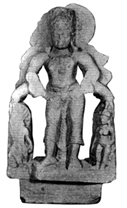
The god with his usual iconographic features and pose is shown with a desiccated sinewy physical form. So far a unique type of Visnu, the image is believed to be a representation of the god's abhicharika or malevolent aspect, is the large image, now in Indian Museum, and tentatively assigned to the 7th century AD. Of the Brahmanical deities, two Surya/ Visnu images from Bengal, one discovered at Kasipur in the 24 Parganas, and the other from Deora in Bogra district (fig 7) appear to be find immaculate examples of the 7th century post-Gupta style. Both the images are carved and complete with their charioteer, other attending men and women and the chariot drawn by seven galloping horses.
Their vitality, plastic modelling and meditative faces endow them with real qualities of a worshipable icon. The Kasipur Visnu, about 90-cm high, is in black basalt, and seems to be one of the best examples of Bengal art in her artist's favourite stone. The Visnu from Deora is carved in bluish basalt. The former Surya is in the collection of Asutosh Museum, Kolkata, and the latter is in the Varendra Research Museum, Rajshahi.
Some of the museums in Europe and United States of America are now rich with Indian sculptures of the ancient and medieval periods, including examples from the 6th-7th century Eastern India. For an instance, The Cleveland Museum of Art possesses a boldly carved Visnu seated on his vehicle Garuda in black stone (H. 80 cm) and a number of Buddha images belonging to the period and the region. But for more examples of Buddhist images, especially for various Bodhisattva and Tara forms, the collections of Nalanda Museum and Indian Museum are extremely significant.
A fine representative of the expression may be recognised in a standing gilt bronze Manjushri discovered from Salar, near Mahasthan in Bogra, and now in the Varendra Research Museum (fig 8). In his slightly moving stance, the Boddhisttva is in the gesture of boon giving by his right hand and protection by the left.
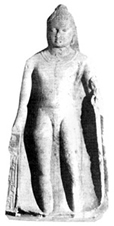
The lyrically poised figure, with a face spiritually enlivened, this Manjushri is one of the finest bronze sculptures so far found in the 7th-8th century Bengal. Another interesting bronze image, once gilt with gold-leaf, comes from Deulbari in the Comilla district, and represents the Brahmanical goddess Sarvani. The image, now lost, was dedicated by Prabhadevi, queen of Devakhadga, the ruler of south-east Bengal in the third quarter of the 7th century AD. Though the image is crude, especially in comparison with the Manjushri, the presence of these two images is important evidence to prove the introduction of the technique of metal casting in Bengal by the end of the 7th century AD.
Besides stone and metal, stucco was also practiced as a medium of plastic art in the early 7th century Bengal. Excavations at the site of raktamrttika-vihara, a monastery near karnasuvarna in the Murshidabad district, have yielded a number of much dilapidated stucco figures, including human heads. One of them, now in the West Bengal State Archaeological Museum, shows a softly smiling face, reminding some of the similar stucco faces of contemporary nalanda.
For about one hundred years, from c 650 AD to 750 AD, a period of turmoil in Bengal, there was no patronage for such a cost-oriented medium of art as sculpture. As a result no worth mentioning sculpture, whether in stone or metal, assignable to the late 7th or early 8th centuries could be found in Bengal proper, though in Bihar images of gods and goddesses were carved in isolated centres.

When in the middle of the 8th century the foundation of the Pala kingdom was laid, the situation began to improve. The kings were ardent devotees of the religion of Tathagata, and its Mahayana version received liberal patronage from them. While Dharmapala founded several monasteries and temples in Bengal and Bihar, Devapala’s munificence brought new glories to olden Buddhist centres like Nalanda. The Buddhist monasteries of the period were great repositories of Indian knowledge and wisdom, and universities for their academic dissemination. Some of the monasteries included techniques of image making in their courses of learning, and maintained atelier and furnace for the purpose.
The art developed over a period of four hundred years and more in eastern India under the Palas and the Senas. It is natural that the art could not remain the same all through, and the laws of evolution would play its role in finalising the general features of the school, which is known as the 'Pala-Sena School'. Besides the time factor, the local ideals and preferences of forms also made some impression on the development of the style. The school's basic characteristics include its immense productivity, both in the mediums of stone and metal, preponderance of gods and goddesses, belonging to Buddhist as well as Brahmanical pantheon, and increasing stylization of figures and decorative elements. The artist had to adhere to the injunctions laid down in the iconographical texts on image making. But even working under such restrictions the artist did not fail altogether in leaving the stamp of his personal genius on his creations; and this he achieved by the dexterity of execution and attainment of visually perfect forms. What is important to note is that, in spite of obvious similarity in many Pala-Sena Buddhas or Visnus, no two images of any of the deity are fully identical. Variation, even in a minute form, is always there in the images of the school.
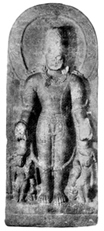
From the evidence of sculpture, it is possible to discern that there was a revival of art ideals of the Guptas under the Palas in eastern India and under the Gurjara-Pratiharas in the Ganga-Jamuna valley in the early 9th century. A testimony of Taranath, the 17th-century Tibetan historian of Indian Buddhism, is very relevant in this context. In his work he records that two artists, Dhimana and his son Vitpala, highly proficient in the techniques of metal-casting, engraving and painting, lived during the time of Dharmapala and Devapala, and they followed the tradition of Naga art, which, as we know, flourished in the post-Kusana and pre-Gupta Mathura region. This was the region where the Gupta classical art first emerged out of the experiences of the Kusana days. In all likelihood, Dhimana and Vitpala took initiative in reviving the Gupta classical norms in eastern Indian art in the late 8th and early 9th centuries.
Since Bihar was a part of the Pala kingdom from almost the beginning, it would be necessary to take into account the sculptures of the region, along with those of Bengal proper. Of the Pala sculptures the earliest dated example, assigned to the 26th regnal year of Dharmapala (c 775-810 AD), is from Gaya in Bihar. Two dated bronze Balaramas and a stone Tara of the days of Devapala also belong to the region. In fact, the hoard of bronze images, discovered at Nalanda from archaeological strata marked as of Devapala, provides the stylistic basis for the 9th century Pala sculpture. From this century onwards sculptures were carved and cast in abundance in various places of Bihar and Bengal, making it easier to examine the stylistic development of the school.
[Image:Sculpture07.jpg|left|thumb|400px|Fig-7: Surya/Visnu, Deora, Bogra]] Stylistically speaking, the Pala-Sena art of the 9th to 12th century AD evolved in broad outlines almost parallel to the art of Ganga-Yamuna valley, though not without some of its distinctive features. The basic characteristic of the evolution through centuries in both regions is intentness for maintaining the rounded human forms as of the Gupta period. But feelings for floridness and multiplicity are among the features that made the sculptures of the period different from those of the Guptas. The floridness may be recognised in the execution of various motifs and designs on the stele, pedestal and ornaments on the person of the figure, while the multiplicity in the introduction of subsidiary figures on the sides and sometimes around the central one as parshvadevatas. Increase in the number of ratha projections on the pedestal, and stylisation in the treatment of lotuses providing asanas or seats for the figures are pointers to the sculptures of the later centuries. These are the general trends in style that may help distinguishing a 9th-10th century image from an example of the 11th-12th century.
In the chronological sequence of the Pala sculptures the first major examples are those stone reliefs on the basement of the Buddhist temple at Paharpur, which have already been mentioned above as belonging to the third group and datable with the foundation of the temple by Dharmapala sometime in the last quarter of the 8th century AD. This group of reliefs represents various subjects including the legend of Krsna. This Krsna is not however of the Brahmanical hierarchy, but Krsna who is popular in every Bengali household as a pet child of mother Yashoda, the eternal lover of the gopis, and a daring exploiter as the divine hero. This group of sculptures also depicts several scenes from the epics, Mahabharata and Ramayana. Though not as refined and rhythmically poised as the figures of the first group treated above as examples of the post-Gupta style, the large number of panels of the group show narrative scenes with several male and female forms in action. In these scenes the artist succeeded in expressing himself more freely, almost in a popular style found in the terracotta plaques discovered from the same site. These sculptures, though early products of the Pala school, are unique for their lively themes and popular expressions. But such examples are rare in the development of the school in the following centuries, when images meant for worship by the devotees of different religions and creeds dominated the entire scene with iconographical characteristics.

A great centre of the Pala art is Nalanda, where Buddhist images in stone and metal were profusely produced throughout the Pala period from 9th century onwards. The two major features of the images are their pedestal and the backing or aureole. Two types of pedestal are found in this early Pala phase: singhasana or lion-borne seat and triratha or base with single projection and receding moulds. The Nalanda images of Panchika and Hariti, both in bronze and with inscribed dates of Devapala, are found in seated posture on the singhasana, while the two Balarama figures of the same time, one from Nalanda and the other from Kurkihar or Kukkutarama-vihara, also in south Bihar, stand on triratha base. The Balaramas show over the transverse bar a seven-hooded snake as providing a canopy for the god, but in other images the place is occupied by an oval-shape halo with flame motifs on its border, which is typical of the style. The vertical bars on sides of the figure are adorned with gaja-singha or lion-on-elephant forms, and occasionally with swans. Such pedestals and aureoles are undoubted derivations from the Gupta tradition, both in their concepts and motifs, but here they are found to be more stylized. In the following centuries, more specifically in the 11th and 12th centuries, they became conventionalized and even cumbrous.
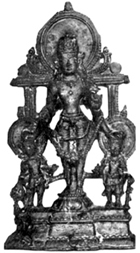
As for the figurers of the early Pala phase, they retained the plastic modelling and gliding contour lines of the Gupta style, as also the sensitivity of the flesh and, in cases, meditative yogic eyes and blissful smile. For example, the bronze image of the Buddhist god Panchika referred to above, bear all these characteristics in its excellently preserved form represented in a balanced ratio with the pedestal and the aureole. The image is now in the possession of National Museum, New Delhi. The Balarama from Kurkihar is also remarkable for his relaxed stance and sensitive plastic modelling.
In comparison, however, Bengal has so far yielded only a few sculptures of the time, and they mostly represent Visnu. Two standing bronze Visnus, one from Kumarpur, Rajshahi (H. 26 cm) now in the Varendra Research Museum (fig 9), and the other of unknown provenance in the possession of the Bangladesh National Museum, Dhaka, show similar composition with oval halo surrounding the head and strictly frontal pose. More interesting seems, however, a Visnu on flying Garuda from Agradigun in Dinajpur. Carved in black basalt, and preserved in the Asutosh Museum, it shows the god in a relaxed pose with soft and sensitive modelling in a composition balanced by the stylized spread of the wings of the bird, which is in a human form.
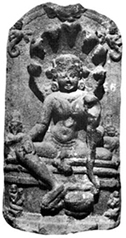
The Pala art steadily progressed under the immediate successors of Devapala. In numbers, too, the carved and cast images much increased, not only in Bihar but also in the different parts of Bengal. The 10th century sculptures discovered from various parts of Bengal include a large number of Brahmanical cult deities along with the Buddhist images. For instance, several Manasa images represent an iconic type scarcely known in earlier sculptures of the region.
One from Tapan in West Dinajpur and another from Ghatnagar Porsha in Rajshahi (fig 10), both in the Varendra Research Museum, open up a new compositional diversion. Same may be said about another image of the same museum, showing Laksmi-Narayana in a pose not unlike that of Uma-Maheshvara. The Laksmi-Narayana couple (H. 24.4 cm) from Ehnail, West Dinajpur (fig 11), in their softly modelled embracing composition represents one of the most impressive sculptures of the century.
In comparison the Uma-Maheshvara (H. 35 cm) from Boram in the Purulia district of West Bengal, and preserved in the State Archaeological Museum in Calcutta, shows a distinctively different style. Here the God and the Goddess are also in an embracing position but in a detached mood befitting of a divine couple. But an interesting aspect of the image is its dichotomy in style. While the Maheshvara is presented with stance and features of the post-Gupta norms, the Uma is in the form of a woman of local ethnic type with wide-open eyes. In Bengal sculptures presence of the local popular trend is however found throughout the Pala-Sena period. Another interesting collection of the West Bengal State Archaeological Museum is the Kartikeya, found in the Kalikamora village in West Dinajpur. The god along with his vehicle peacock, on which he flies, is modelled in extreme pliability, as if not in black stone but clay, and moves lively in an informal way.
Tenth-century Bengal is also rich in Buddhist sculptures, both in stone and bronze, possibly more in bronze than stone. An interesting stone image of a Buddha in earth-touching pose (H. 69 cm), now in the State Archaeological Museum in Calcutta, comes from Bareya in the Nadia district. It shows the Master in the post-Gupta proportions but with an elaborate aureole, which represents five dhyani Buddhas above and two Bodhisattvas on two sides. What is significant is the conical shape of the usnisa crowned by a stupa-like object. This peculiarity of Buddha head is a typical development in the Pala period and the type of image later travelled from Bengal to Myanmar and Thailand.
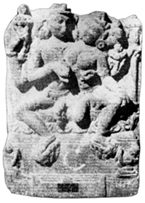
Though some bronze Buddhas have appeared in different places of north Bengal, the important centre of it was southeast Bengal, which was known as Samatata or Harikela. The country was ruled from the middle of the 8th to the middle of the 11th centuries by two successive dynasties, Deva and Chandra, the kings of which were devout Buddhists. Archaeological discoveries at Mainamati-Devaparvata in Comilla district have revealed a number of Buddhist monasteries and stupas, as also a large quantity of terracotta plaques and stone and bronze images. Most of the bronze Buddhas of the site, generally small in size, show a physiognomic type with a weird look representing a popular art ideal.
Jhewari, a village about 16 km south-southeast from the city of Chittagang, is known for yielding a hoard of bronze sculptures consisting of sixty-one Buddhist images. These images were cast between the late 7th and the middle of the 11th centuries, but majority of them was of the 10th. They therefore represent the second phase of Buddhist bronzes, if we regard the early ninth century Nalanda bronzes associated with the Pala king Devapala as of the first phase. The Jhewari Buddhas are of three distinct stylistic types. The first type, represented by standing Buddha in diaphanous robes and protecting gesture, is unmistakably of the Sarnath style. The second type Buddhas are of the same popular style as the above-described Mainamati Buddhas. In the third type we find the stamp of the genius of the Chittagang artists, for they present one of the most exquisite Buddha forms ever cast or carved. The type shows the Master in his earth-touching pose, seated on a cushion. The finest examples of the type bear certain physical and stylistic features that make them distinct from their Nalanda counterparts.
While most of the Nalanda bronze Buddhas wear the upper robe covering both the shoulders, the Jhewari Buddhas (fig 12) leave their right shoulders bare. The robes of the Nalanda images are with striations, while that of the Jhewari examples is diaphanous. Besides, the sharp nose, plastically treated arch of the brows, the half-closed eyes and sensitive leaps of the countenance of Jhewari Buddhas are points of departure. The treatment of the hairline in a separate plastic layer from that of the forehead, prominent nippers and incised double-curved line of the wrapping of the lower robe are other distinctive features. Altogether these Buddhas add, both formally and aesthetically, a new idiom to the representation of the Master.

But the most significant Buddhist image, belonging however to the early eleventh century, comes from Mainamati-Dedvaparvata (fig 13). The image in bronze is a colossal representation of the Bodhisattva-Vajrasattva, being 1.5 m high even in sitting position. It is the largest and possibly the best-preserved metal sculpture so far discovered in eastern India. In its anatomical proportions of the body, balanced pose of the hands and perfect geometrical composition the Vajrasattva is a remarkable creation, combining in one the previous experiences of Nalanda and Jhewari. With equal emphasis on plain surface, as of the body, and ornamentation, as of the crown and pendent earrings, the image stands between the classical and medieval ideals. It is one of the supreme expressions of Bengal's plastic art. From a contemporary bronze head of a life-size Bodhisattva-Avalokiteshvara image from the same site it seems that the Mainamati artist was a master in the cire perdue or hollow casting technique of bronze.
While the ninth and tenth century Pala sculptures thrived on the ideals of the Gupta classical art, from the eleventh century the art of Bengal began to show marked stylistic changes by introducing new features on the persons of the deities and their pedestals and aureoles. Though not divorced from the experiences of the two preceding centuries, they actually evolved a new aesthetic vision which has been termed the 'medieval style' in the parlance of the art historians. The sculptures of the style relied more on decorative elements than the principal objects, and as a result they became more and more overwhelmed by the increasing number of subsidiary figures, boldly carved ornaments on them and multitude of motifs on pedestals and aureoles, especially as time passed from the eleventh to the twelfth century.

The bronzes of the eleventh century represent the medieval style in its early maturity, by exhibiting dexterously cast and chiselled figures and decorative elements. For instance, the crowned Buddha images, standing in protecting gesture on a double-petalled lotus based on a pancharartha pedestal and surrounded by an halo with stylized flame-motifs all along on its border, provide an archetype for the images of medieval Bengal style. What is significant is that the Buddha-type as evolved in the days of Vigrahapala III in south Bihar set norms also for the Vishnus in bronze found from different parts of Bengal proper. Two bronze Vishnus, both of the eleventh century and now in the Asutosh Museum, one from Sagardhighi in Murshidabad district and the other from Rangpur in north Bengal, may be cited as examples. But still more interesting is a silver Visnu from Sonarang in Vikrampur, Bangladesh, now in the Indian Museum, showing more elaborate and complicated decorative elements achieved in a skill rare even among the immaculately executed metal images of eastern India.
Though the lineal development of Bengal sculpture is best understood with the help of the Buddha and the Visnu images as found in different centres of art in Bihar and Bengal, they represent mostly a single compositional type, that is of samapda or strictly frontal vertical form. But there are representations of other images, as of the Buddhist goddess Marichi or the Brahmanical goddess Mahisasuramardini, which show figures in diagonal pose, while the images of Yashoda and Krishna (?), also known as sadyajata or new born, and of Anantashayi-Visnu or Visnu lying on the snake Ananta represent examples of horizontal compositions. It is possible to witness other still more sophisticated forms, which include such images as of the Tantric-Buddhist deity Vajratara in the collection of Indian Museum. From the aesthetic viewpoint more significant however are the dancing figures of Ganesha and Shiva-Nataraja. An example of the former from the collection of Asutosh Museum, found at Hajinagar, Rajshahi, shows an excellent combination of curvacious modelling, rhythmic movement and flowing contour lines.
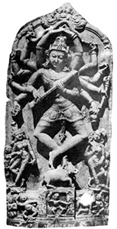
But still more interesting seems to be the Siva-Nataraja, both in concept and executional refinement. Most of the Shiva-Nataraja (fig 14) images have been found in the districts of Dhaka and Tippera in south-east extreme of Bengal. These images stand in contrast with those of south Indian Natarajas. Here the god is dancing in a soft cadence on his vehicle bull, who is also dancing in the corresponding rhythm of his Master, while the south Indian Nataraja dances in tandava, pressing under his feet the evil form of Apasmara. A supreme example of Siva-Nataraja, inscriptionally designated as Nattesvara, of Bengal version is now in the National Museum, Dhaka.
This large image, which comes from Sankarbandha near Ramapal in the Dhaka district, is represented with weapon wielding ten hands, which are swinging in the dancing rhythm of the god. Its elaborate backing and pedestal are also conceptually rich. These two forms of dancing images of Siva-Nataraja and Ganesa lead us into the twelfth century art of Bengal.
The twelfth century images, irrespective of their being in stone or bronze, represent the last and final phase of the East Indian sculpture. The style of this phase is an extension, elaboration and proliferation of that of the eleventh century. But a change in aesthetic emphasis is recognized in the style, effected chiefly by a political phenomenon that had serious impact on the socio-political life of the people of Bengal. In the beginning of the century the Senas, who hailed from Karnataka, displaced the Palas as rulers from the most parts of Bengal proper. They brought with them the orthodox social and religious practices of the Brahmanical faith; and as its result images of the Puranic deities, such as Visnu, Shiva, Shakti, Surya and Ganesha were numerously produced. Besides, several minor deities like Kartikeya, Sarasvati, Manasa and Ganga were given importance. Brahma, once a major divinity, was represented, too. All these images, as also those of the Mahayana-Tantrayana Buddhist gods and goddesses, introduced certain new composition of forms. But their stylistic distinction from those of the eleventh century's are marked not that much in the shapes of the images as in their overburdening ornamentation. The elaborate and overwhelming decorative motifs on the pedestal and the aureole became so dominating that the principal figure, the deity itself, appeared subservient to them.
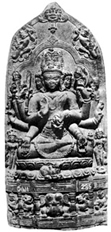
The aureoles were now covered with the attending divinities, lion-on-elephants, swans, kinnaras and kinnaris, gandharvas and gandharvis, and finally at the top by the kirtimukha, a face of a mythical animal. The Senas, who were accustomed to it in their homeland Karnataka, introduced the last member kirtimukha in the Bengal art as a decorative feature. Occasionally architectural motifs, such as the faeade of a temple or a stupa came to occupy the aureoles. The pedestals also grew more ornate and ratha projections increased in number, ranging from five to eleven. Undulating creepers and reptiles were introduced to cover the faces of the ratha planes, and in between their coils appeared floral as well as anthropomorphic forms. As a result the pedestals of multi-planes lost their sharp angles and became semi-circular in shape. But a more interesting change is noted in the cutting out of the backstone along the contour of the figure of the main deity, effecting fully rounded plastic forms in place of high reliefs, and succeeding in turning the aureole to a real halo or prabhamandala by providing for a light from behind. This device, initiated possibly in the late eleventh century, gave the images of the final phase a new stylistic dimension.
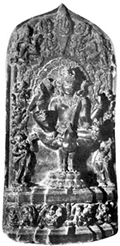
In the twelfth century production of sculptures continued to be as prolific as in the preceding one. It would therefore be very difficult to discuss even the century's masterpieces. Here only a few would be mentioned for a general appreciation of the Pala-Sena style in its final phase. The Varendra Research Museum preserves, among many others, some of the finest examples of the sculptures of this phase, including the image of Shiva, Sadashiva (fig 15), Surya, Kartikeya (fig 16), and Syama Tata - all coming from different districts of north Bengal. The Avalokiteshvara of the West Bengal State Archaeological Museum, and the Brahma and the Khasarpana Avalokiteshvara of the Indian Museum, and hailing from same north Bengal, are also remarkable examples of the art at its most matured expression. The development in the south Bihar was similar, so far as emphasis on ornamentation and fulsome figures are concerned, though a slight variation may however be noted in several figures showing longish forms with a sharp bend at the waist.
The Khasarpana Avalokiteshvara from Nalanda and now in the Nalanda Museum is an instance of the style. Other remarkable sculptures from the region revealing the style in its best are the bronze trinity of Buddha, Avalokitesvara and Maitreya, found at Fatepur, now in Bodhgaya Site Museum, and the Lokanatha from Kurkihar, and preserved in the Patna Museum. Two images, one of the Mahisasuramardini, from the Hoogly district in West Bengal, and in the Asutosh Museum, and the other of the Garuda, from Rajshahi and in the Indian Museum, are remarkable for their distinctive accent on the bold curvacious forms, possibly bearing the imprint of the Hoysala art of Karnataka.
After the Muslim conquest of Bengal in the early thirteenth century, the defeated Senas retreated to the east of river Padma, and lingered as a royal power in the eastern most part of the country till about the middle of the century. In spite of their loss of resources, the Senas continued to encourage the art of image carving. But from the viewpoint of style, nothing new emerged in the period. Thus ends the long and varied story of the Pala-Sena sculpture as a regional East Indian style of distinction, flourishing in the early medieval period. Significantly, however, the style of the art spread, hand in hand with the Mahayana-Tantrayana Buddhism, much beyond the Bengal borders to continue and develop in Nepal and Tibet in the north, Myanmar and Thailand in the east and Sri Lanka and Indonesia in the south. [Asok K Bhattacharya]
